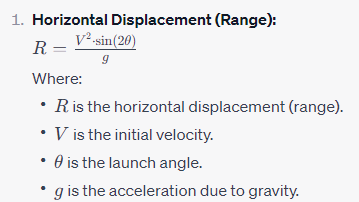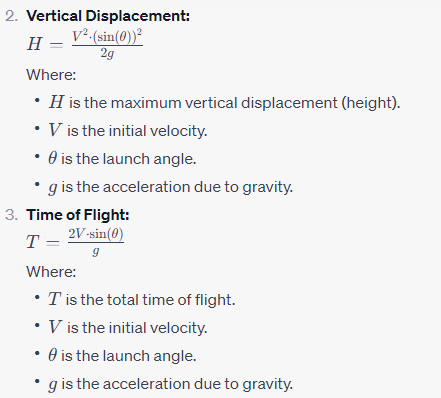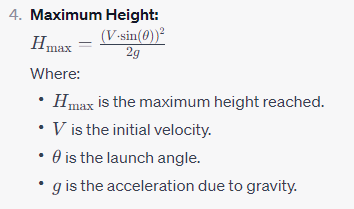
Projectile motion formula is a fundamental concept in physics that describes the motion of objects projected into the air under the influence of gravity. In this 1500-word article, we will provide a comprehensive overview of projectile motion, including its fundamental principles, key equations, real-world applications, and examples.
Introduction to Projectile Motion Formula
Projectile motion occurs when an object is launched into the air and moves along a curved path, influenced by both its initial velocity and the force of gravity. This motion can be seen in various everyday scenarios, such as throwing a ball, shooting a projectile from a cannon, or launching a rocket. To understand projectile motion fully, it's essential to break down its components and explore the mathematical equations that describe it.
Components of Projectile Motion Formula
Projectile motion consists of two perpendicular components: horizontal motion and vertical motion.
- Horizontal Motion: The horizontal component of projectile motion is constant, assuming there is no air resistance. An object in horizontal motion moves at a uniform velocity, and this velocity remains unchanged throughout the motion.
- Vertical Motion: The vertical component of projectile motion is influenced by gravity. The object is subjected to a constant acceleration due to gravity (usually denoted as 'g') that points downward. The initial vertical velocity determines the object's ascent and descent.
Also Check - Heat Loss Formula
Key Equations of Projectile Motion Formula
To describe and analyze projectile motion, several key equations are essential. These equations help us determine various parameters, such as the range, maximum height, time of flight, and velocity at any point in the trajectory.



These equations allow us to calculate various aspects of projectile motion, making it a valuable tool for understanding and predicting the behavior of objects in motion under gravity.
Also Check - Static Electricity Formula
Real-World Applications of Projectile Motion Formula
Projectile motion has numerous practical applications across various fields, including physics, engineering, sports, and entertainment. Some common examples include:
- Sports: Projectile motion is fundamental in sports like baseball, basketball, and golf. Players use their understanding of the motion to make accurate throws, shots, and passes.
- Engineering: Engineers use projectile motion principles when designing and testing rockets, missiles, and aircraft. Calculations related to launch angles, velocities, and trajectories are essential in these applications.
- Physics Experiments: Projectile motion is often studied in physics laboratories as it provides a simple yet insightful way to explore the concepts of kinematics and gravity.
- Entertainment: Special effects in movies often involve projectiles, such as exploding objects, falling debris, or characters in flight. Understanding the physics of projectile motion helps create realistic scenes.
Also Check - Pressure Formula
Examples of Projectile Motion Formula
Let's explore a couple of examples to demonstrate how the equations of projectile motion are applied in real-life scenarios.
Example 1: Throwing a Ball
Suppose you throw a ball with an initial velocity of 15 m/s at an angle of 30 degrees with respect to the horizontal. Calculate the following:
- Range (horizontal displacement).
- Maximum height.
- Time of flight.
Using the equations mentioned earlier, you can easily calculate these values.
Example 2: A Soccer Goal Kick
In a soccer game, a player kicks the ball at an angle of 45 degrees with an initial velocity of 20 m/s. Calculate the maximum height the ball reaches and the time it takes to reach the ground.
By applying the projectile motion equations, you can find the answers to these questions and gain a deeper understanding of the physics involved in the game.
Projectile motion is a fundamental concept in physics with broad applications in various fields. By understanding the principles and equations associated with it, you can analyze and predict the motion of objects in the presence of gravity. This knowledge is not only valuable for academic purposes but also for practical applications in engineering, sports, and entertainment, where accurate predictions of projectile motion are essential.
Projectile Motion Formula FAQs
What is projectile motion?
What are the two components of projectile motion?
What is the acceleration due to gravity, and how is it denoted?
What are the key equations for projectile motion?










